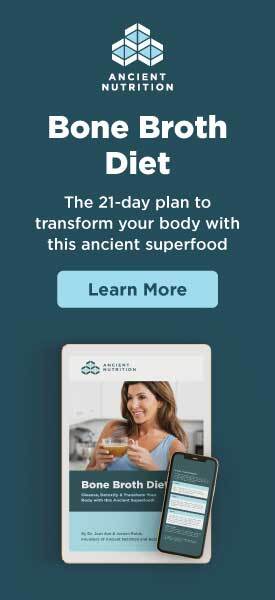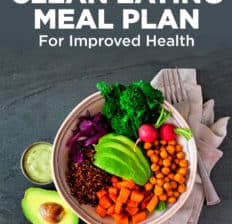This Dr. Axe content is medically reviewed or fact checked to ensure factually accurate information.
With strict editorial sourcing guidelines, we only link to academic research institutions, reputable media sites and, when research is available, medically peer-reviewed studies. Note that the numbers in parentheses (1, 2, etc.) are clickable links to these studies.
The information in our articles is NOT intended to replace a one-on-one relationship with a qualified health care professional and is not intended as medical advice.
This article is based on scientific evidence, written by experts and fact checked by our trained editorial staff. Note that the numbers in parentheses (1, 2, etc.) are clickable links to medically peer-reviewed studies.
Our team includes licensed nutritionists and dietitians, certified health education specialists, as well as certified strength and conditioning specialists, personal trainers and corrective exercise specialists. Our team aims to be not only thorough with its research, but also objective and unbiased.
The information in our articles is NOT intended to replace a one-on-one relationship with a qualified health care professional and is not intended as medical advice.
Clean Eating Meal Plan: Improve Your Diet & Health
August 12, 2022
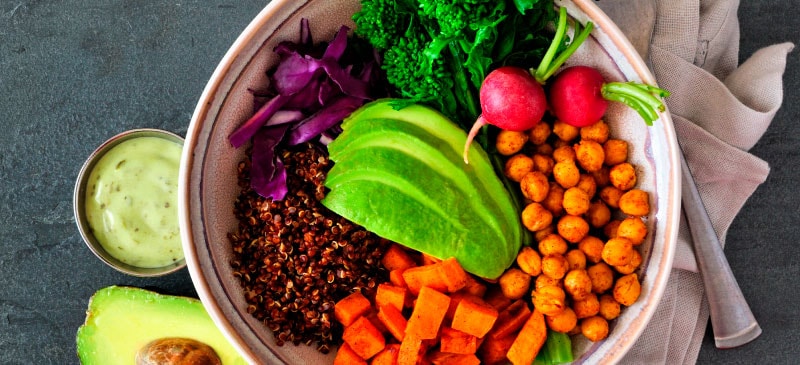
Notice how in recent years there’s been a growing trend toward eating more “whole foods,” while avoiding things that commonly cause allergies, sensitives, sugar cravings and weight gain? Even many big-name supermarket chains are making a serious effort to clean up store shelves and remove suspicious ingredients from products — such as trans fats, for example. This movement has been nicknamed “clean eating,” which basically means eating foods as close to their natural state as possible.
Practicing clean and mindful eating is a powerful alternative to the unhealthy, detrimental fad diets many have grown accustomed to. It’s also a great way to detox your body. So what is clean eating exactly, and how do you do it? Let’s find out.
What Is Clean Eating?
New to eating clean? It’s a lot like eating the “healing diet” that Dr. Axe has been prescribing for years — considering it eliminates or reduces processed products, food irritants and allergens.
Instead, it focuses on quality ingredients that supply essential nutrients and emphasizes cooking more nutritious recipes at home.
Most clean eating programs have these main goals in mind:
- Decrease inflammation — Inflammation has been linked to nearly every chronic disease there is, since it damages healthy cells, arterial walls, joints, brain tissue and the digestive tract. By reducing inflammation, your body is better able to heal from any disease and prevent future diseases frm forming. This is exactly why you want to add lots of anti-inflammatory foods (like vegetables, fruits, nuts, seeds, ancient grains, healthy fats and clean protein) to your clean eating meal plan.
- Help lower acidity and alkalize the body — Your body has an optimal pH range that it fights hard to maintain, but acidic foods (like soda, processed meats and refined grain products) make your body less alkaline than it likes to be. All diseases thrive in an acidic environment, which is why the alkaline diet is ideal for protecting your body from the effects of aging and a poor lifestyle.
- Better control blood sugar (glucose) levels — The level of sugar you consume impacts metabolic and hormonal functions, including how you store body fat and the level of stress hormones you produce. You can help manage your weight with clean eating by skipping refined carbohydrates and sugary foods or beverages. That’s because clean eating balances blood glucose levels, allowing insulin receptors to work correctly and producing enough satiety hormones (like leptin) to maintain a healthy body weight.
- Remove toxins and artificial ingredients — Toxicity in our environment has been linked to obesity, hormonal imbalances and autoimmune diseases. We acquire toxins from low-quality animal products, produce sprayed with pesticide chemicals and all sorts of refined foods high in artificial ingredients.
- Provide optimum nutrients — Nutritional deficiencies are common today since a large percentage of the food supply is processed and stripped of natural vitamins, minerals, antioxidants and enzymes. Including more fresh, real ingredients in your diet helps fight oxidative stress, slow the aging process, improve mental capacity and increase energy levels.
Benefits:
One of the major upsides of eating clean is that inflammatory, processed products are greatly reduced, while all sorts of real and mostly fresh/raw foods are encouraged.
Unfortunately in America today, many of the foods we eat are highly processed or genetically modified, so any diet that recommends you eat more natural ingredients is a major step in the right direction.
Processed foods tend to be irritating and hard to digest, since they can damage the delicate lining of your digestive tract. Any people dealing with allergies, heart disease or cardiovascular issues, arthritis, digestive dysfunction, insomnia, depression, or anxiety — basically all forms of chronic disease — owe it to themselves to eat cleanly.
Not only does eating clean help reverse symptoms of most lifestyle or inflammation-related diseases, but it can also be empowering, making you feel more energetic, self-confident, upbeat and calm.
Related: How to Use a Food Journal to Benefit Healthy Eating Decisions
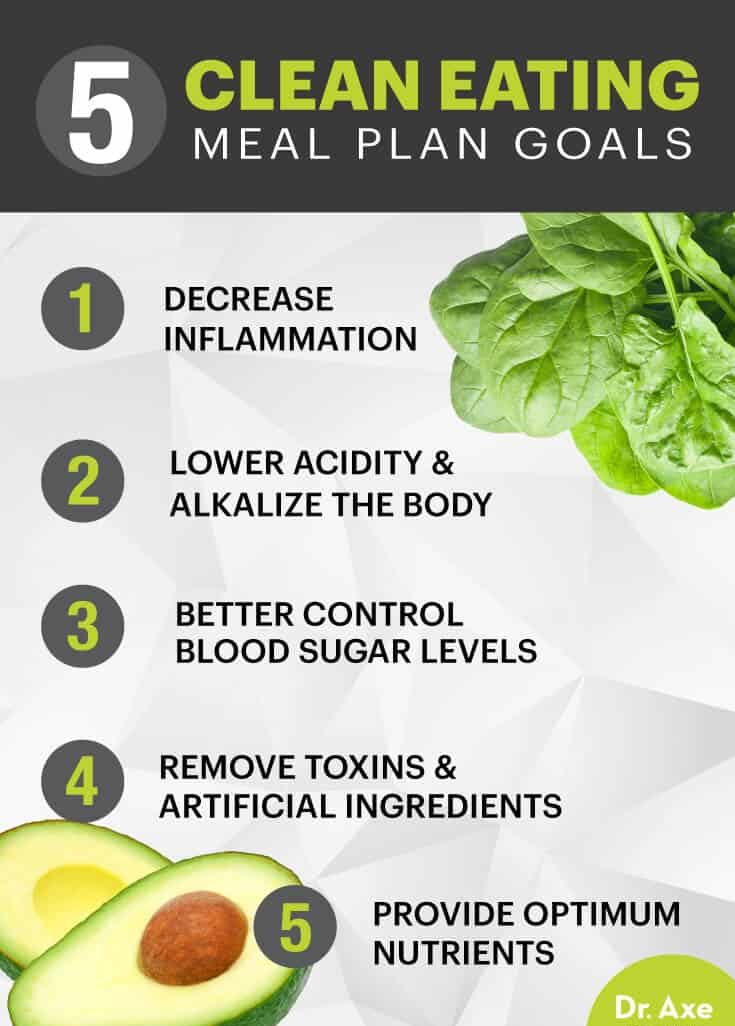
How to Follow: Foods to Eat/Avoid
How do you begin clean eating? While this way of eating means different things to different people, some basic principles apply to just about everyone.
A clean eating meal plan consists of eating mostly a plant-based diet, with fresh foods (especially vegetables and some fruit), along with adequate amounts of quality protein and healthy fats.
Some people might associate clean eating with being “plant-based” or even vegetarian/vegan, but this isn’t necessarily true. It’s not about eliminating animal foods and only eating plant foods; it’s about creating balance and choosing the best quality you can.
Dr. Axe personally recommends about equal amounts (30 percent each or so) of clean protein sources, healthy fats and low-glycemic carbohydrates in the forms of fruits and vegetables.
Foods to Include:
- Fruits: strawberries, oranges, lemons, blackberries, limes, raspberries, pears, apples, blueberries, etc.
- Vegetables: broccoli, cabbage, bell peppers, Brussels sprouts, tomatoes, asparagus, garlic, cucumber, onions, ginger, etc.
- Nuts: almonds, cashews, pecans, pistachios, macadamia nuts, walnuts, Brazil nuts
- Seeds: hemp seeds, pumpkin seeds, sunflower seeds, chia seeds, flaxseeds
- Legumes: black beans, kidney beans, pinto beans, lima beans, chickpeas, lentils
- Whole grains: quinoa, barley, buckwheat, millet, brown rice
- Healthy fats: olive oil, coconut oil, MCT oil, grass-fed butter, ghee, avocado oil
- Dairy products: goat milk, kefir, goat cheese, probiotic yogurt, raw milk
- Meat: grass-fed beef, lamb, venison, wild game
- Fish: wild-caught salmon, tuna, mackerel, anchovies, sardines
- Poultry: organic chicken, turkey, goose, duck
- Cage-free eggs
- Condiments: hummus, guacamole, apple cider vinegar, mustard, salsa, balsamic vinegar, liquid aminos
- Herbs and spices: basil, oregano, rosemary, turmeric, cinnamon, paprika, cumin, black pepper, etc.
- Natural sweeteners: stevia, raw honey, maple syrup, dates, monk fruit
- Beverages: water, tea, kombucha, bone broth
Foods to Avoid:
- Refined grains: white rice, pasta, white bread, breakfast cereals
- Added sugars: soda, juice, candies, cookies, granola bars, baked goods, ice cream
- Unhealthy fats: refined vegetable oils, shortening, hydrogenated fats, fried foods
- Conventional meat and poultry
- Farmed fish
- Processed foods: potato chips, crackers, frozen meals, microwave popcorn, processed meat, instant noodles, etc.
If a clean eating meal plan sounds far removed from how you currently eat, here are three steps you can take to get started:
1. Switch Up Your Fats
Work on removing “bad fats” and replacing them with nourishing “good fats.” This means choosing products that are free of hydrogenated (trans fats) and partially hydrogenated oils as much as possible, which is pretty easy to do if you cook with real fats at home and avoid packaged products or fried foods most of the time.
In addition to nixing trans fats, skip refined vegetable oils (including soybean oil, canola oil, sunflower and safflower oil), and instead use healthy fats like coconut oil, real olive oil or grass-fed butter when cooking.
2. Focus on High-Quality Animal Products
If you eat a lot of animal proteins (meat, poultry, eggs, fish, dairy), you want to make sure you focus on purchasing the best-quality products you can. Many studies have linked factory farmed meats and commercial dairy with inflammation, cancer and heart disease.
Opt for proteins that are grass-fed, pasture-raised, cage-free and wild-caught. This ensures you consume plenty of healthy fats such as omega-3s. Plus, there’s also concern over accumulation of pesticides, herbicides, antibiotics and hormones in conventional meats and other animal foods.
If you can find it hard to digest dairy, try raw dairy products, such as yogurt or kefir, which are probiotic foods and immune system boosters.
3. Remove Added Sugar and Make Your Grains Whole
Refined sugars and refined grain products make up a growing percentage of most people’s calories today. That’s a big problem, considering high-glycemic or refined sugars cause elevated glucose levels and contribute to insulin resistance, leading to weight gain, premature aging and degenerative diseases.
On top of that, refined sugary foods are usually “empty calories,” providing little nutrition, and many even contain antinutrients that hinder your ability to absorb nutrients like vitamins and minerals. Even many gluten-free foods can lack nutrients, so don’t necessarily fall for marketing claims on packaged foods.
Check ingredient labels carefully for added sugar (which can be listed under dozens of different names), and make your grains “ancient” and 100 percent whole.
Limit snacks and drinks that spike blood sugar most, which includes most cereals, sweetened drinks like juice or soda, white rice, white pasta, and white bread. We also get a lot of added sugar from sneaky sources like condiments, canned soups or sauces, lunch meats, pizza, “natural” fruit drinks, etc.
Wondering what to eat instead? Emphasize low-glycemic carbohydrates in the forms of fruits and vegetables, plus 100 percent (ideally sprouted) grains, which have high amounts of fiber, enzymes, vitamins, minerals and antioxidants.
Fiber in whole grains and plant foods helps slow the absorption of sugar into the bloodstream, keeps you fuller, improves energy levels, and supports gut and heart health.
Related: Food Waste Study: The Staggering Amount of Uneaten Food in the U.S.
Sample Clean Eating Meal Plan
What can I eat in a day of clean eating? Here’s an example of meals that include some of the best clean eating foods:
Breakfasts:
Lunches:
Snacks:
Dinners:
Risks and Side Effects
In recent years, there’s been a growing concern over people who strictly eat clean to the point that it becomes obsessive and unhealthy. This has been termed “orthorexia,” a condition in which a clean eater takes things too far and starts experiencing high amounts of stress and preoccupation over his or her diet.
As the National Eating Disorder Foundation puts it, orthorexia is a fixation on righteous eating that “starts out as an innocent attempt to eat more healthfully, but causes othorexics to become fixated on food quality and purity. They become consumed with what and how much to eat, and how to deal with slip-ups … Self-esteem becomes wrapped up in the purity of orthorexics’ diet.”
There’s no doubt that a healthy diet is important for your health, but the amount of anxiety some people experience over making the perfect food choice all the time can really backfire.
If you notice yourself spending more and more time researching or picking out foods at the grocery store, becoming anxious when eating out at restaurants with friends or struggling to find foods that fit your growing criteria of what’s considered “healthy,” you might be developing orthorexia and should consider speaking with a professional.
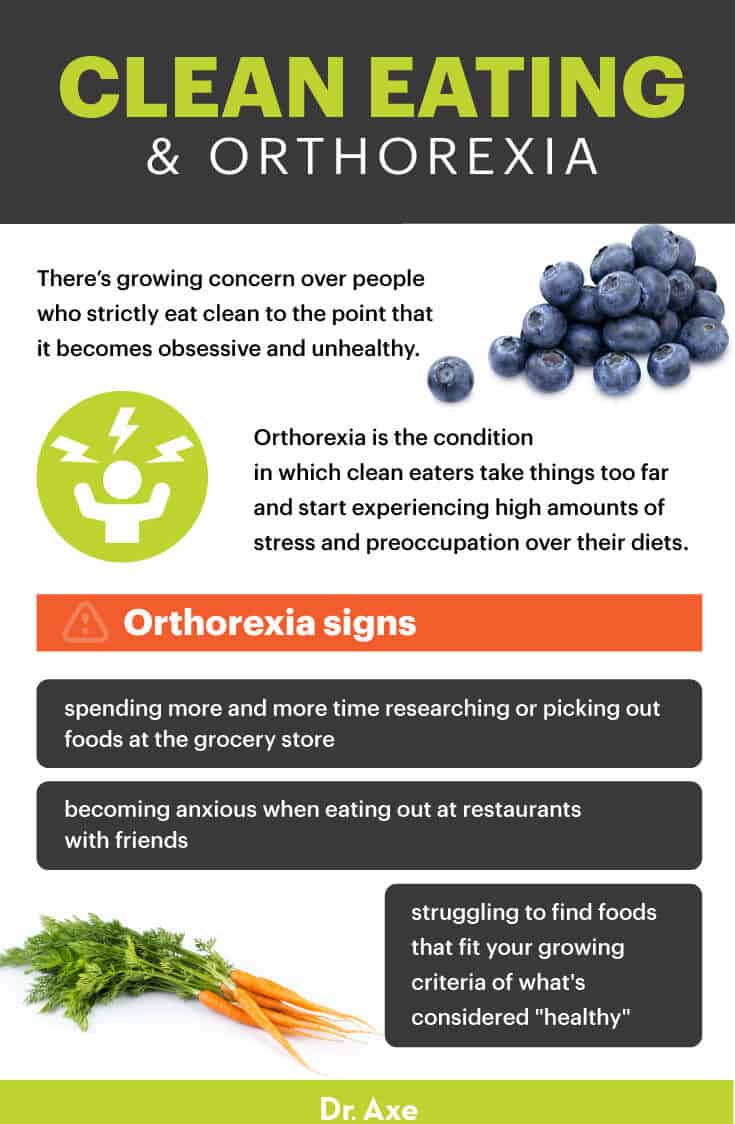
Conclusion
- Clean eating basically means eating foods as close to their natural state as possible as part of a clean eating meal plan.
- This approach can help decrease inflammation, lower acidity and alkalize the body, better control blood sugar levels, remove toxins and artificial ingredients, and provide optimum nutrients.
- What are clean eating foods? Aim to eat a variety of fresh, plant-based produce and ingredients along with adequate amounts of quality protein and healthy fats (such as fish, grass-fed meat, free range eggs, olive oil, nuts and seeds).
- Here are three steps you can take to dramatically help improve your nutrient intake and lower your toxin exposure: Switch up your fats to get more good fats and less bad fats, focus on high-quality animal products, remove added sugar, and make your grains whole.













